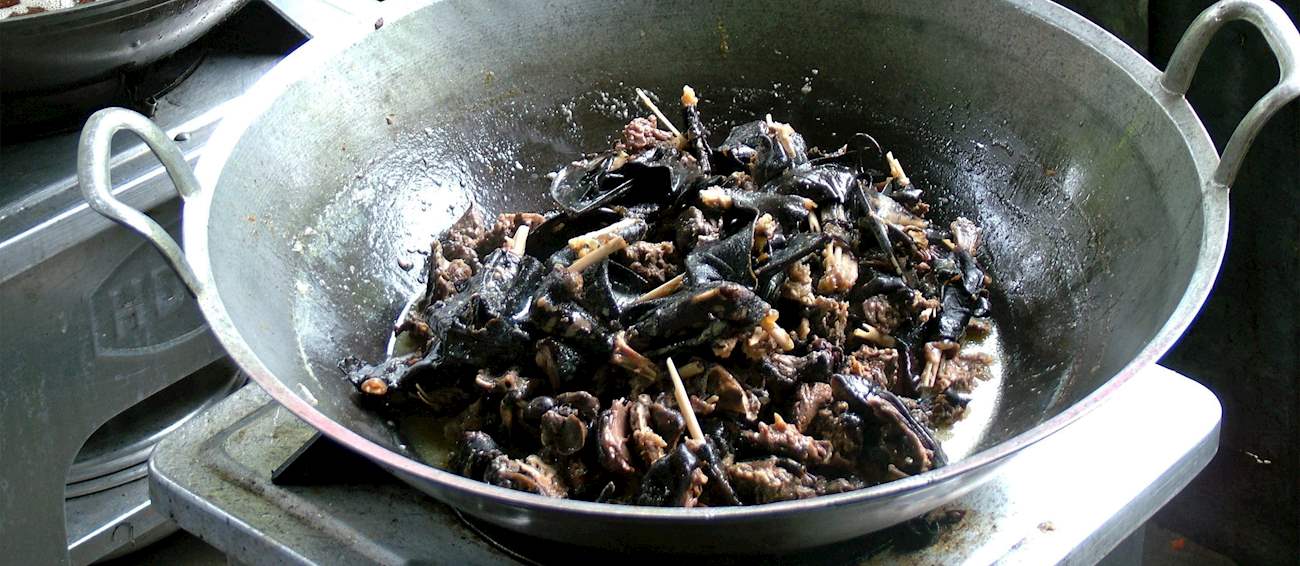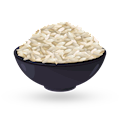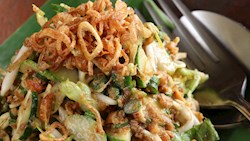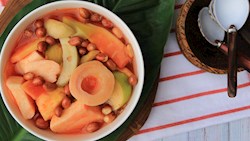Tinutuan is Indonesian rice porridge that originated in North Sulawesi in the city of Manado, but it's also often associated with Minahasa. The most common vegetables used in tinutuan include spinach, pumpkin, cassava, and corn, but other vegetables can be used as well.
Due to its liquid consistency, it is served in a bowl, together with salted fish and a spoonful of sambal on top. This savory porridge is originally vegetarian, but on special occasions, meat is sometimes added to the dish. It is commonly served for breakfast, and people usually flock to the stalls in the early morning to get this nutritious breakfast.
MOST ICONIC Tinutuan
View moreMAIN INGREDIENTS
Traditionally made by the native Minahasan people and hailing from North Sulawesi, this Indonesian dish employs fruit bat as the main ingredient. Though bats are often fried or grilled, the most popular way is to incorporate them into paniki, the traditional soup-like dish.
The usual procedure starts with grilling the bat to remove all the hairs covering its body. The bat is then cleaned, its intestines are removed, and it is cut into smaller chunks and boiled in water. The dish is finished off with the addition of fried onions, garlic, ginger and chili paste, leeks, curry leaves, lemongrass, and coconut milk.
Lawar is a versatile Balinese dish usually consisting of chopped meat and vegetables that are typically mixed with coconut, chili powder, shrimp paste, kaffir lime leaves, galangal, and turmeric. Traditional lawar is made with pork or turtle, but chicken, duck, or beef can also be used.
Pig blood is added for color and flavor in most variations of this dish. Lawar is usually prepared for ceremonies and other special occasions, so it is often made in large quantities. However, it can also be found at any restaurant or warung in Bali.
MOST ICONIC Lawar
View moreMAIN INGREDIENTS
Pepes tahu is a traditional dish hailing from West Java. It consists of spiced and steamed tofu that’s cooked in banana leaves. The ingredients usually include tofu, banana leaves, bell peppers, green onions, and a spice paste consisting of shallots, garlic, sugar, salt, and hot chili peppers.
The tofu is drained and mashed, then combined with the spice paste, bell peppers, and green onions. The combination is wrapped in banana leaves, steamed, then served while still warm with rice on the side. Alternatively, pepes tahu can be grilled instead of steamed, if desired.
MAIN INGREDIENTS
Bakso ayam is a traditional dish and a type of bakso (meatball) originating from Indonesia. These meatballs are usually made with a combination of chicken, garlic, oil, salt, sugar, corn starch, and baking powder. The ingredients are shaped into chicken meatballs that are boiled in water.
Once taken out of the pot, the meatballs are plunged into ice-cold water. They can be eaten as they are or incorporated into a delicious chicken meatball soup called sup bakso ayam. It's recommended to use lean chicken breast when preparing bakso ayam.
Nasi jagung is a traditional rice dish originating from Indonesia. This simple dish is made with a combination of rice, sweet corn kernels, and water. The rice and corn are boiled in water and stirred from time to time until the corn is fully cooked and the rice is dry and fluffy.
Nasi jagung is stirred well and then served while still hot. This dish is popular in areas where rice is difficult to obtain or expensive, so corn is used to add bulk to the rice.
Kupat tahu is a traditional dish consisting of ketupat (a type of rice cake) and tofu in peanut sauce. The ingredients usually include rice cakes, tofu, bean sprouts, chili peppers, peanuts, garlic, brown sugar, water, and kecap manis soy sauce.
The tofu is fried until golden brown, the bean sprouts are blanched, and the peanuts are fried, then combined with garlic, chili peppers, and water in order to create the peanut sauce, which is additionally mixed with brown sugar. The rice cakes, fried tofu, and bean sprouts are topped with the peanut sauce, and the dish is then drizzled with sweet soy sauce.
If desired, kupat tahu can be enriched with lime juice and garnished with shrimp crackers. This dish is traditionally served for breakfast.
MAIN INGREDIENTS
Wajik or wajid is a traditional sticky rice cake originating from Java. It's usually made with a combination of glutinous rice, palm sugar, coconut milk, pandan leaves, and salt. The glutinous rice is soaked, washed, steamed, and cooked in a skillet with coconut milk until it's absorbed.
Pandan leaves are cooked with palm sugar until caramelized, and coconut milk and salt are then added to the mixture. Once the mixture is boiling, sticky rice is stirred in, and wajik is poured into a baking pan. After a few minutes, it's cut into diamond shapes and served.
This soto variety combines chicken or beef with a creamy broth that is enriched with coconut milk and a myriad of different spices and herbs such as galangal, turmeric, ginger, and coriander. The meat is cooked, then shredded and fried before it's doused in a flavorful broth.
The dish is finished off with various condiments such as boiled eggs, fish cakes, prawn crackers, potato fritters, or fried shallots, while the rice is typically served on the side. As its name suggests, this soto variety hails from the city of Medan, where it's regarded as a signature dish and a highly sought-after regional delicacy.
OTHER VARIATIONS OF Soto
MOST ICONIC Soto Medan
View moreMAIN INGREDIENTS
Buntil is a traditional dish hailing from Java, consisting of grated coconut, red peppers, chili, onions, garlic, anchovies, salt, and sugar wrapped in taro, cassava, or papaya leaves. The combination is boiled in coconut milk and spices such as garlic, turmeric, lemongrass, and lemon leaves.
Buntil is often prepared at home, but it can also be found in local restaurants or street side stalls called warungs. The dish is especially popular during Ramadhan.
TasteAtlas food rankings are based on the ratings of the TasteAtlas audience, with a series of mechanisms that recognize real users and that ignore bot, nationalist or local patriotic ratings, and give additional value to the ratings of users that the system recognizes as knowledgeable. For the “73 Worst Rated Indonesian Foods” list until April 20, 2025, 7,368 ratings were recorded, of which 4,757 were recognized by the system as legitimate. TasteAtlas Rankings should not be seen as the final global conclusion about food. Their purpose is to promote excellent local foods, instill pride in traditional dishes, and arouse curiosity about dishes you haven’t tried.








































































